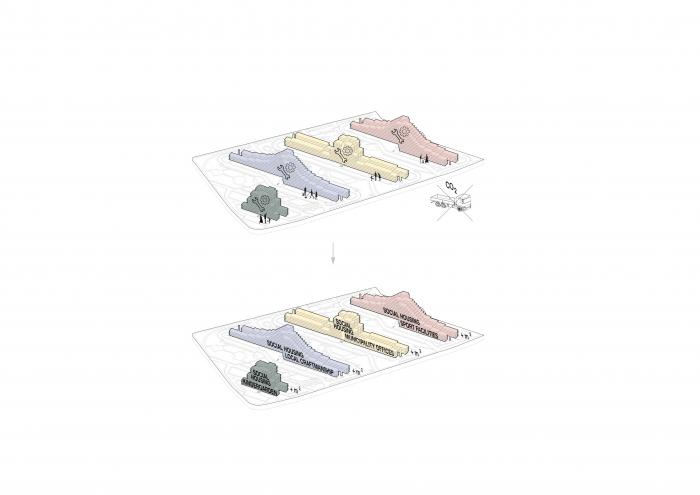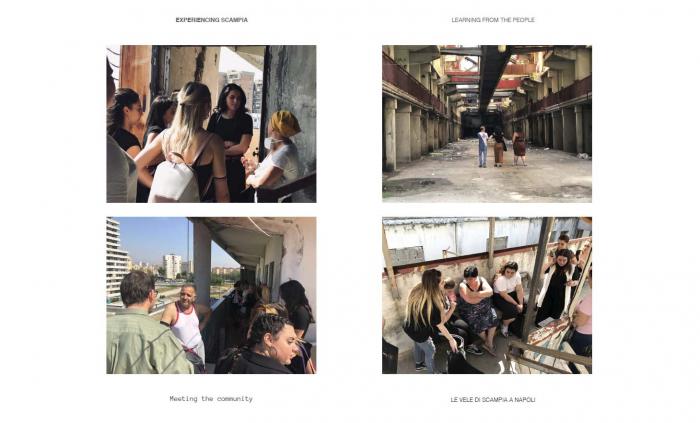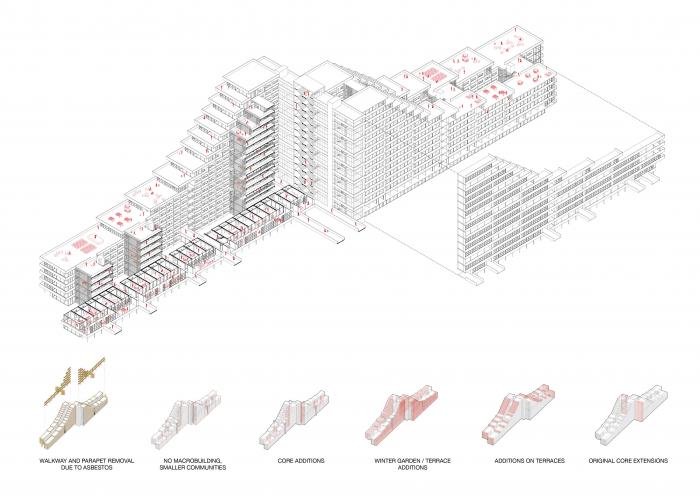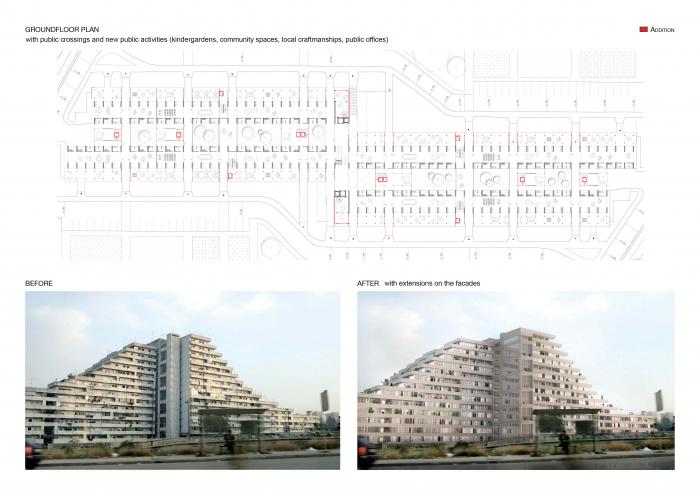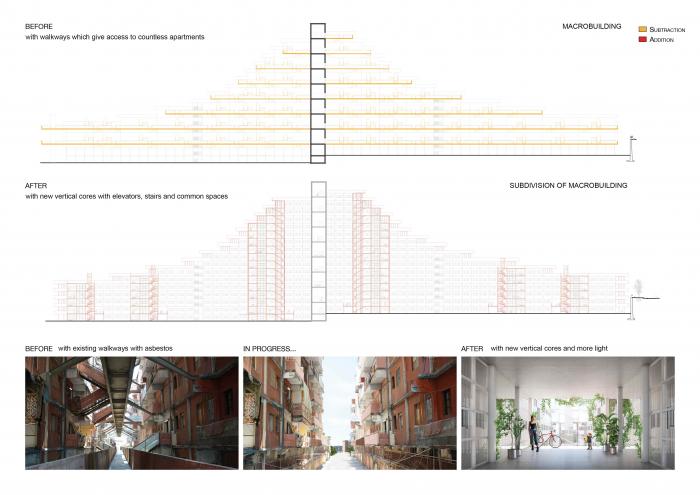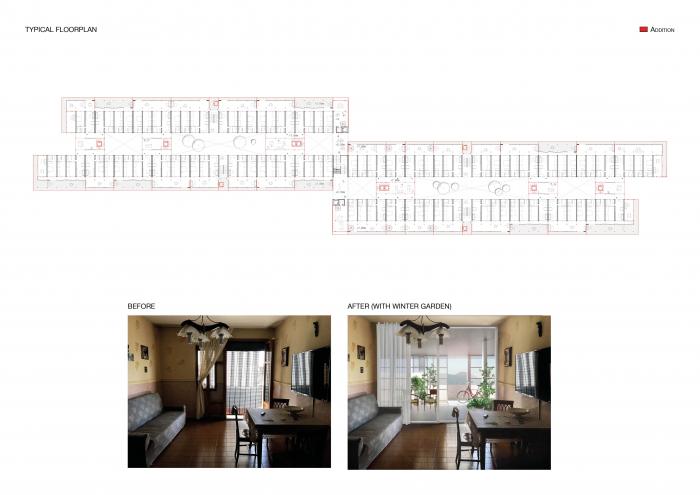At a time when our cities are facing an environmental and socio-economic emergency, the project reconsiders the concepts of sustainability and recycling, seizing the opportunity and responsibility to work with existing buildings, enhancing them and adapting them to contemporary ways of living. Entering the flats of the Vele, one perceives and appreciates the richness and value that each family, despite living in difficulty, has brought to the buildings and their disagreement with demolition.
Le Vele is a social housing project built in Scampia in 1975. Severely compromised in its construction and isolated by a road system it became a ghetto and developed into a site and symbol of organised crime featuring in the movie and TV series Gomorrah. Of the seven original mega blocks, three have been demolished and four are still inhabited. Many of the inhabitants daily work to ensure that life in Scampia continues in a dignified manner and in opposition to degradation and crime. The issue is to imagine a better life for the remaining buildings and their inhabitants. The project attempts to bring - with a limited budget, minimal actions and the largest possible impact - the Vele buildings to conditions of maximum comfort and satisfaction as a positive alternative to their demolition and the reconstruction of new homes. The critical understanding of the buildings and their dynamics of growth and development, through the attendance of Scampia and its inhabitants, is the point of departure. The project is determined by a series of strategic interventions, prompted by the main concerns for the buildings and their inhabitants. Negative elements and problematic conditions are used as potentials. The new circulation allows for the apartments to be accessible to both old and disabled people as well as for the space between the two bodies of units to take on more daylight, transparency and possibilities of visual relationship. The need for a safer and clearer vertical circulation determines the insertion of a series of cores, also containing common spaces, which generate a sequence of courts and a subdivision into autonomous building blocks. This allows for the transformation of the mega building into more communities that may have relations. New extensions on the facades offer more space and light for each apartment. The introduction of a series of public crossings at the ground floor generates a new permeability, supporting new public functions and community services.
Please highlight how the concept/idea can be exemplary in this context
What to do with these deteriorated buildings has been widely discussed and still represents an unsolved problem. At a time when our cities and our lives are facing an environmental and socio-economic emergency, it is essential to reconsider the concepts of sustainability and reuse, seizing the opportunity and responsibility to work more and more with the existing building stock, enhancing it and adapting it to contemporary ways of living. My project tries to prove that it is fundamental to complete what has been left unfinished and to improve the general condition of these buildings. In this way, the transformation of this buildings could represent a positive alternative to demolition, which in most cases is chosen as the easiest solution although it involves the use of a significant amount of energy, it generates greenhouse emissions, large volumes of waste and all the problems related with waste disposal. Demolishing has a great cost. The renovation of the social housing blocks can radically improve the space and quality of life of its occupants and optimise their economic and environmental cost of living. The starting point is to not demolish, subtract or replace building elements unless they need to be removed for structural, health and safety reasons. The approach of my project is to see the capacity of the space to be transformed, taking the existing situation in an economic and social framework, thinking about sustainability and using as little material as possible to offer better living conditions. By doing so, the transformation can push the building to a maximum of pleasure and comfort as a positive alternative to its demolition and rebuilding. One has to appreciate with a positive eye what was interesting in the initial project and its architecture. Taking advantage of the existing and adding to it produces something more interesting than demolishing and starting from scratch, rebuilding houses that often lack architectural quality.
Please highlight how the concept/idea can be exemplary in this context
The project is articulated through a series of actions, motivated by the main concerns of the inhabitants and a critical understanding of the buildings. Due to health and safety reasons, the existing walkways, which give access to the flats, have to be replaced. The walkways are considered uncomfortable by the inhabitants because their narrow width does not allow them to pass through and stop to socialise at the same time. Over the years, the walkways have been an ideal place for illegal trafficking and still give the inhabitants a sense of unease and insecurity. The buildings have no entrances, allowing outsiders to enter and walk freely on the walkways. The need for safer circulation leads to the insertion of a series of vertical cores, containing lifts, stairs and common spaces. The new circulation makes the flats accessible to disabled and elderly people and allows the space between the two buildings to take on more natural light, transparency and the possibility of visual relationships, thus ensuring that the entrances are controlled. The mega-building generate a series of communities that can have relationships, allowing inclusion and at the same time more control and security. The addition of extensions on the external facades with their own structure, independent of that of the building, allows individual flats to expand and achieve a more flexible organisation. These new spaces along the facades are not heated but function as a passive system for regulating the microclimate of each flat. The elimination of partitions and corridors within the flats with the internal circulation moved along the external façade, offers more generous, better ventilated and illuminated spaces. The addition of a series of volumes on the short fronts of the building allows for new public uses on the roof terraces. The introduction of a series of public crossings on the ground generates a new permeability in the building, supporting new public functions and community services.
Please highlight how the concept/idea can be exemplary in this context
Many of the inhabitants work daily to ensure that life in Scampia continues in dignity and in opposition to degeneration and crime. The demolition of the buildings has no basis other than the illusion of wanting to erase a reality that cannot be erased by demolition alone. The problems of the neighbourhood will not disappear with these buildings. They must be addressed and resolved. Change can happen and the transformation of the Vele can be an opportunity to finally redeem Scampia and its inhabitants. I started my project by building a relationship with the people and what I learned from them changed and improved the project in a significant way. Entering the flats in the Vele, one perceives and appreciates the richness and value that each family, despite living in difficulty, has brought to the building. Against all expectations, the dwellings display a decorum and dignity resulting from a clear sense of belonging and possession on behalf of the inhabitants and from a care that is in contrast to the abandonment and degradation of the common areas. The size of the flats and their internal organisation provide a quality and generosity of space that is not always found in affordable and social housing. The flats have large terraces and an elevated position overlooking the Vesuvius landscape. The dwellings give the building a sense of domesticity that cannot be easily dismissed and have clear potential for use and transformation. Public participation has been and will be crucial in the development of my project. I have been introduced to the inhabitants of the Sails by Mashia, an inhabitant that I met at a cultural and professional training center of the neighborhood. At the Sails of Scampia you don't go unnoticed but with Mashia, I had privileges. Everyone there knows her, everyone knows everyone. This microcosm is Mashia's universe, the background of her whole life and she is proud of it.
Please highlight how this approach can be exemplary
Sustainability, aesthetics and inclusion have all proven valuable throughout the design of my proposal. In my project these three dimensions are closely connected and must work together. It’s fundamental to reconsider the concept of sustainability and stop the possible demolition of these buildings. My project by recognising the potential for transforming existing spaces, looks at the building within precise economic limits and with great attention use of as few materials as possible. Research aimed at recognising the potential for transforming existing spaces, looking at the building within precise economic limits and with great attention to sustainability and the use of as few materials as possible. Reuse and transformation are considered as the possibility to generate in the building conditions of maximum quality in terms of generosity and comfort of the spaces. The new extensions on the façades give a new image of the buildings which can help to counter the collective imagination that identifies these buildings as symbols of crime and degradation. The contribution of the inhabitants of Scampia was essential for the development of my project. The buildings are inhabited by more than 40,000 people even though a real census was never conducted. You cannot imagine a future for Scampia without knowing the inhabitants of the Sails and understanding, through them, the problems, limitations and potential of these buildings. The inhabitants involved were enthusiastic about the inclusion aspects of my project. They believe that the new common spaces of the vertical cores, the new uses and facilities imagined on the large public terraces and on the ground floors can only improve the conditions of the neighbourhood and create new relationships among the community. The attitude and the strategy of my project, built on a participatory process, can be replicated and adapted to the many examples of deteriorated social housing buildings in Italy and abroad.
My project consistently challenges the prevailing view that demolition is preferable to transformation. The municipality of Naples is encouraging the trend to demolish these buildings thinking that it can be the only possible solution. Existing constraints don't have to be limitations. Nowadays more than ever reusing and transforming existing structures, when possible, should be the mainstream practice. We are very lucky to live in cities rich in history and complexity. As architects, we have to deal with this complexity which hides an incredible richness that pushes us to find answers and solutions, thinking about how to intervene differently, in a sustainable way. In Scampia since the end of the 1990s, there has been a succession of interventions and proposals for various types of action, some of which have been implemented, but never capable of generating real redevelopment of the neighbourhood or appropriate policies. The inconclusive action of the public began to be flanked by social and cultural action of local associations and cooperatives, which affected the lives of the inhabitants to a small extent but with real prospects. It should be emphasised that many of the inhabitants are working to ensure that life in Scampia continues in a dignified manner and in opposition to degradation and crime. The media's campaign of denigration, which over time has turned the Sails into the symbol of crime, has been countered by a public opinion that has begun to look to the recovery and rebirth of the neighbourhood, also looking with interest at the buildings and what they represent as evidence of an architectural culture. There are many examples in Italy and abroad of buildings that are in a state of disrepair and that instead of being demolished could be transformed, opting for a more sustainable and probably better solution. My project includes and listens to the community of the Sails of Scampia, imagining a better future for the building and its inhabitants.
My project is at an early stage of development. Until now I have made lots of research and developed the project with the participation of the inhabitants of Scampia. I will continue to carry on the project with the support of the Centro Hurtado, cultural and professional training centre, which is attended by many young inhabitants of the “Sails“ in Scampia willing to change their living conditions. Learning from these people and from their knowledge of the buildings has been a great contribution to my project. It was fundamental getting to know the point of view of the inhabitants who surprisingly supported the idea of not demolishing the buildings in opposition from what the media and the press had conveyed. I perceived their sense of belonging to these buildings, contrary to what press and politicians would make you believe. In 2016, the municipality of Naples approved an urban regeneration programme which includes the demolition of three of the four remaining buildings and the redevelopment of the neighbourhood through the renovation of the last remaining building and new construction. The planned demolition of the first of the three buildings was completed two years ago but since then everything has stopped. There are conflicting opinions among politicians and citizens and many are against demolition. The demolition of three of the seven buildings in 2003 has led to nothing. All the promised new houses have still not been built but the few built lack urban and architectural quality and have not solved any problem of the neighbourhood. The demolition of this last building according to the plan of 2016 has left behind a wasteland and no new house has been built. I will work on a publication about the project in order to get support from the Municipality, the local communities and the central government. I will present my idea to the new mayor hoping he will present the project to obtain funds from the Next Generation EU.
As a first step I will work on a publication about the project. At the same time I will present the idea to the new mayor hoping to immediately get his involvement and have the Municipality examine and develop my project in order to apply for funds from complementary investments to the Italian PNRR for public housing regeneration resources (Italian Law 01/07/2021 n. 101) within both the Italian programme “Sicuro verde e sociale: riqualificazione dell’edilizia pubblica”, aiming to improve energy efficiency, resiliency and seismic safety as well as social conditions in public housing fabrics, and the National Innovative Programme for the Quality of Dwelling (Pinqua). A participatory process will immediately be started as well as a technical and economical feasibility project to be placed as base for the award of public contracts for works in Italian PNRR and PNC for the transformation of the Sails of Scampia. The process will involve other architects, experts from relevant fields, Scampia’s inhabitants, NGOs in surrounding neighbourhoods, all to work together and in coordination with the Naples Municipality Technical Office. I will organise workshops and participative meetings in order to clearly depict all needs, services and programmes which the project will embrace and sustain for improving wellness and social inclusion in Scampia. The whole project will be structured in different actions to be implemented over time and in accordance to available funds. I will communicate the different actions through the media in order to get support for the immediate transformation of these buildings and against their demolition, commencing as soon as possible within June 2023 with the implementation of first relevant strategic and demonstrative actions. The New European Bauhaus Prize would give to the project great visibility and credibility. I am sure that the Municipality of Naples will be willing to support a project celebrated by the European Union.
@Izzo, 2022
Content licensed to the European Union.
